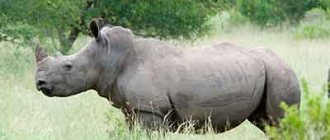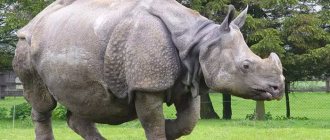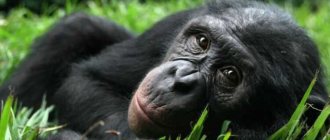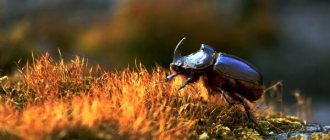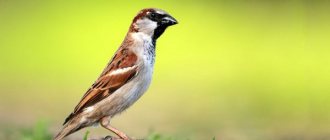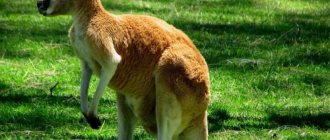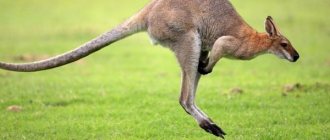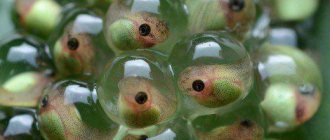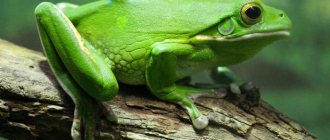The Javan rhinoceros is probably the rarest large mammal on the planet. The population is no more than 50 individuals in the wild and none in captivity. This species is very similar to the Indian rhinoceros, but has a much smaller head, smaller body size and less visible skin folds. The Javan rhinoceros has one horn, about 25 centimeters long. According to recent data, females may have no or very small horns. The upper lip is better suited for grasping food due to its pointed shape. A rhinoceros can be 2-4 meters in length, up to 170 centimeters in height and weighing 900-2300 kilograms. The Javan rhinoceros is dark gray in color.
This species of rhinoceros lives in tropical forests with a good supply of water and mud in which to wallow. They prefer low-lying areas, although they can sometimes be found at altitudes above 1000 meters on the island of Java, Indonesia. The Javan rhinoceros chooses a solitary lifestyle, with the exception of couples during the mating season and young mothers caring for their offspring. Life expectancy is about 30-40 years.
Not much is known about the biological reproduction of this species, as no cases of cubs being born in captivity have yet been recorded. Sexual maturity in females occurs at the age of 5-6 years, in males at 10 years. The mating season lasts from July to November, and the gestation period is unknown, but probably, similar to the great Indian one-horned rhinoceros, is about 16 months. The Javan rhinoceros is considered more adaptable to life than other modern rhinoceros species. In tropical forests and other parts of their historical range, the species occupied lowland areas, especially along watercourses.
Keeping Javan rhinoceroses in captivity
An attempt to keep Javan rhinoceroses in a zoo was unsuccessful. In the 19th century, 4 individuals of Javan rhinoceroses lived in the zoos of Adelaide, Calcutta and London. Over the entire history of keeping these animals in zoos, 22 individuals were housed in captivity, but there may have been more, since Javan rhinoceroses were often not distinguished from Indian rhinoceroses.
The last Javan rhinoceros in captivity died in 1907. Breeding programs have proven to be lengthy and expensive, and since they are unsuccessful, the chances of conservation of the Javan rhinoceroses are extremely slim. In 2008, there were no Javan rhinos left in captivity.
Attention, TODAY only!
Similar
Seychelles sacwing
A small bat, weighing about 10 grams, is the Seychelles sacwing. It prefers to live in cold caves with an entrance free of obstacles, as well as a horizontal ceiling on which mice rest. Bagwings feed on large insects.
Observations have shown that the bagwing, when hunting, flies in zigzags, both high (15-20 m) and low (1.5-2 m) above the ground
The number of animals is no more than 100. Now they are found only on two islands of the Seychelles archipelago - Silhouette and Mahe. The main factors behind the extinction of bagwings are the threat from barn owls and wild cats that moved to the Seychelles from outside, as well as habitat deterioration.
Notes
- Sokolov V. E.
Five-language dictionary of animal names. Mammals. Latin, Russian, English, German, French. / under the general editorship of academician. V. E. Sokolova. - M.: Rus. lang., 1984. - P. 122. - 10,000 copies. - ↑ (Retrieved March 20, 2011)
- ↑
- ↑ (English)
- ↑
- ↑ Dinerstein, Eric.
The Return of the Unicorns; The Natural History and Conservation of the Greater One-Horned Rhinoceros. - New York: Columbia University Press, 2003. - ISBN 0-231-08450-1. (English) - ↑ Rookmaaker, L.C. (June 2002). “Historical records of the Javan rhinoceros in North-East India.” Newsletter of the Rhino Foundation of Nature in North-East India
(4): 11-12. (English) - ↑ (English)
- Grubb, P.
Artiodactyla. - Baltimore: Johns Hopkins University Press, 2005. - pp. 637-722. (English) - Schenkel, R. and Schenkel-Hulliger, L.
The Javan rhinoceros (
Rhinoceros sondaicus
Desm.) in Udjung Kulon Nature Reserve: its ecology and behavior. - Field Study 1967 and 1968. Acta Tropica 26: 97-134., 1969. (English) - ↑ Foose, Thomas J.;
Nico van Strien. Indian subspecies of the Javan rhinoceros - status, survey and conservation action plan = Asian Rhinos - Status Survey and Conservation Action Plan. - IUCN, Gland, Switzerland, and Cambridge, UK, 1997. - ISBN 2-8317-0336-0. (English) - ↑ (English)
- Simon, N. and Geroudet, P.
History of Endangered Animals = Last Survivors - The Natural History of Animals in Danger of Extinction. - New York: The World Publishing Co., 1970. - 275 p. (English) - Daltry, J. C.
Cardamom Mountains biodiversity survey. - Cambridge: Fauna and Flora International, 2000. (English) - ↑ Santiapillai, C. (1992). “Javan rhinoceros in Vietnam.” Pachyderm
.
15
: 25-27. (English) - ↑ van Strien, Nico.
Javan Rhinoceros // Save the rhinos: EAZA Rhino Campaign 2005/6 / Fulconis, R.. - London: European Association of Zoos and Aquaria, 2005. - P. 75–79. (English) - Animal Life, ed. S. P. Naumov and A. P. Kuzyakin, in 6 volumes. - M.: Education, 1971. - T. 6. - P. 415. - 626 p. — 300,000 copies.
- ↑
- Munro, Margaret
.
Their trail is warm: Scientists are studying elusive rhinos by analyzing their feces, National Post
(May 10, 2002). (English) - ↑ Animal life. Volume 7. Mammals / Ed. academic V. E. Sokolova. — 2nd ed. - M.: Education, 1989. - P. 415. - 300,000 copies. — ISBN 5-09-001434-5.
- ↑ (English)
- ↑
- Foose, TJ and van Strien, N.
Asian rhinoceroses. Status and Conservation Plans = Asian Rhinos. Status Survey and Conservation Action Plan. - Gland, Switzerland: IUCN/SSC Asian Rhino Specialist Group, 1997. - ↑ Stanley, Bruce
.
Scientists Find Surviving Members of Rhino Species, Associated Press
(June 22, 1993). - Emslie, R.
African Rhino. Status Survey and Conservation Action Plan. — IUCN/SSC African Rhino Specialist Group. IUCN, Gland, Switzerland and Cambridge, UK, 1999. - ISBN 2-8317-0502-9.} (English) - Dursin, Richel
.
Environment-Indonesia: Javan Rhinoceros Remains At High Risk, Inter Press Service
(January 16, 2001). - ↑
- Raeburn, Paul
.
World's Rarest Rhinos Found In War-Ravaged Region of Vietnam, Associated Press
(April 24, 1989). - Rookmaaker, L. C. (1982). “The type locality of the Javan Rhinoceros ( Rhinoceros sondaicus
Desmarest, 1822).”
Zeitschrift für Saugetierkunde
.
47
(6): 381–382. (English) - Rookmaaker, Kees.
First sightings of Asian rhinos // Save the rhinos: EAZA Rhino Campaign 2005/6 / Fulconis, R.. - London: European Association of Zoos and Aquaria, 2005. - P. 52. (English) - Rookmaaker, L. C.
The type locality of the Javan Rhinoceros (Rhinoceros sondaicus Desmarest, 1822). - Zeitschrift fur Saugetierkunde 47 (6): 381–382., 1982. (English) - Rookmaaker, Kees.
Records of the Indian subspecies of the Javan rhinoceros in India and Bangladesh = Records of the Sundarbans Rhinoceros (Rhinoceros sondaicus inermis) in India and Bangladesh. - 24. - Pachyderm, 1997. (English) - ↑ (English)
- ↑ Lacombat, Frederic.
The evolution of the rhinoceros // Save the rhinos: EAZA Rhino Campaign 2005/6 / Fulconis, R.. - London: European Association of Zoos and Aquaria, 2005. - P. 46–49. (English) - (English)
- (English)
Population and species status
The black rhinoceros is in danger of extinction in some areas. Currently, the total population of the species is about 3.5 thousand animals. Relatively high and stable numbers of black rhinoceroses are observed in Namibia, Mozambique, Zimbabwe and South Africa, which made it possible to allow hunting for them. In these countries, a certain number of quotas are allocated annually to allow the shooting of black rhinoceros. The hunt for white rhinoceros is also carried out according to a very strict quota and in compliance with the strictest controls.
Today, in the International Red Book, Indian rhinoceroses have been assigned the status of a vulnerable species and category VU. The total number of representatives of this species is approximately two and a half thousand individuals. However, in general, the Indian rhinoceros is a relatively prosperous species compared to its Javan and Sumatran relatives.
The Javan rhinoceros is an extremely rare animal, and the total number of representatives of this species does not exceed six dozen individuals. Conservation of representatives of the Sumatran rhinoceros species in captivity does not produce visible positive results. Many individuals die before reaching the age of twenty and without bearing offspring. This feature is due to insufficient knowledge of the species’ lifestyle, which does not allow creating the most favorable conditions for proper maintenance in captivity.
Tigers and people
Currently, there are about 6 thousand living tigers left in the wild, while 100 years ago there were more than 100 thousand. Hunting for these large predators was very popular in the late 19th and early 20th centuries. Stuffed animals were made from killed tigers to decorate the houses of aristocrats, and carpets were made from striped skins.
At the beginning of the 21st century, out of 9 known subspecies, only 6 remained, and all of them are in danger of extinction. The animals are listed on the IUCN Red List as an endangered species. Killing striped predators is prohibited by law all over the world, and in some countries is punishable by death, but this does not stop poachers.
In China, the meat and all parts of the tiger’s body from whiskers to tail are endowed with healing powers, although there is no scientific medicine to confirm this. This product is highly valued on the black market. People are forced to kill some animals for protection if they are caught in cannibalism. Tigers attack people more often than all other representatives of the cat family.
To protect yourself from attacks by predators, you must follow safety rules in their habitats:
- when you see from afar, never run away;
- don't turn your back;
- put a mask with a picture of a human face on the back of your head, an attack always happens from the back;
- knock and make noise loudly while moving through a dangerous area of the forest;
- Do not walk at dusk unarmed or alone.
What is surprising is that in America tigers are kept as pets. The number of such exotic cats, according to statistics, reaches 12 thousand.
Watch this video on YouTube
The reason for the disappearance of Javan tigers is a lack of attention to the surrounding nature. Inappropriate use of natural resources, deforestation and shooting of wild animals may in the near future lead to the extinction of all big cats.
What does a rhinoceros eat?
Rhinos are strict vegetarians, eating up to 72 kg of plant food per day. The main food of the white rhinoceros is grass. With its wide, fairly mobile lips, it can also pick up fallen leaves from the ground. Black and Indian rhinoceroses eat shoots of trees and bushes. Herbivorous animals pull out acacia sprouts right by the roots and destroy them in large numbers. Their wedge-shaped upper lip (proboscis) allows them to grab and break off hanging branches. The black rhinoceros loves elephant grass (lat. Pennisetum purpureum), aquatic plants, milkweed and young shoots of reeds. The favorite food of the Indian rhinoceros is sugar cane. The Sumatran rhinoceros feeds on fruits, bamboo, leaves, bark and young shoots of trees and shrubs. He also loves figs, mangoes and mangosteen. The food of the Javan rhinoceros is grass, foliage of vines, trees and shrubs.
Best articles: Renewable energy sources: examples, characteristics and use
In zoos, rhinoceroses are fed grass, and for the winter hay is prepared for them, in addition to which they rely on vitamin supplements. For the black and Indian species, branches of trees and shrubs must be added to their food.
Rhinos feed at different times of the day. The black one mainly grazes in the morning and evening, while other species can lead an active lifestyle both day and night. Depending on the weather, an animal needs from 50 to 180 liters of water per day. During dry periods, equids can go without water for 4-5 days.
Photo credit: Ltshears, CC BY-SA 3.0
Nutrition
- Animals prefer to stick to vegetarianism. They eat about 70 kg per day. food of plant origin. The diet is based on grass. Animals tear it off with powerful and mobile lips, and also pick up fallen leaves. Some individuals are partial to shoots of bushes and trees. They can tear out an acacia tree with roots, absorbing it in huge volumes.
- The wedge-shaped lip is otherwise called the proboscis. She breaks off the branches. These mammals like elephant grass and also eat aquatic vegetation and reed shoots. Sugar cane is considered a favorite delicacy; bamboo, figs, and mangoes are consumed.
- As for food in captivity, when these representatives of the family are kept in a zoo, they are provided with hay and are also treated to fresh grass. Vitamin complexes must be added. Leaves and shoots are added to the food.
- Giants can feed regardless of the time of day. Individuals of the black species primarily feed in the morning and evening. As for the rest of the rhinoceroses, they can remain active both at night and during the day.
- A huge animal can consume from 50 to 170 liters per day. water. Such indicators are highly dependent on the weather. During drought, individuals are able to go without water for 4-5 days.
Javan rhinoceros and man
A Dutch colonial official with a hunted Javan rhinoceros (Java, 1895)
Threats
The main factor influencing the number of Javan rhinoceroses was and remains poaching for the purpose of obtaining horns. Horn has been traded in China for over 2,000 years because it is believed to have healing properties, particularly aphrodisiac properties. The price of the horn on the black market is more than $30,000 per kilogram, which is three times higher than that of African rhinoceros horns. The skin of this animal, prepared in a special way, was used in the Middle Ages as material for the armor of Chinese soldiers. Some Vietnamese tribes prepared an antidote for snake venom from rhinoceros skin. The Javan rhinoceros's range covers areas with poor populations, so a local resident who hunts a rhinoceros and manages to sell its horn can become rich. Therefore, the fight against poaching is extremely difficult; it is also hampered by corruption. When the Convention on International Trade in Endangered Species of Wild Fauna and Flora came into force in 1975, the Javan rhinoceros was placed on Appendix I for protection, making worldwide trade in the species illegal.
Habitat destruction due to agricultural activity also contributes to the population decline, although this factor is not as significant because the Javan rhinoceros lives in two national parks where agricultural activity is prohibited. Due to the small area of its range, the species is susceptible to disease and inbreeding.
Security
Head of a rhinoceros from the subspecies Rhinoceros sondaicus annamiticus
The Ujung Kulon Peninsula was devastated by the eruption of Mount Krakatoa in 1883. Javan rhinoceroses settled on the peninsula after the eruption, but few people returned, which created a good refuge for the rhinoceroses. In 1931, when the species was on the verge of extinction in Sumatra, the Dutch East Indies government included it in the list of legally protected animals. In 1967, only 25 Javan rhinoceroses were recorded. By 1980, the population had doubled and remained virtually unchanged to this day. Although rhinoceroses in Ujung Kulon have no natural predators, they must compete for limited resources with cattle. The national park is managed by the Indonesian Ministry of Forestry. In Ujung Kulon, 4 cubs were recorded in 2006, which is more than ever before. This suggests that rhinoceroses in the national park continue to breed and their population is slowly but increasing. On February 28, 2011, a female and her calf were captured on video.
Rhinoceroses, native to Southeast Asia, were declared extinct after the Vietnam War ended in 1975. The peculiarities of the fighting - deep raids of punitive units into the jungle, the use of defoliants by American troops - had an extremely negative impact on local ecosystems. In addition, after the war, firearms began to be sold at low prices, which made it possible for local farmers to easily hunt rhinoceroses. The assumption of the extinction of the Vietnamese subspecies was first voiced in 1988. But in 1989, tracks were discovered along the Dong Nai River that belonged to at least 15 individuals. This area became part of Cat Tien National Park in 1992.
Female of the extinct subspecies Rhinoceros sondaicus inermis
, one of which lived at London Zoo for less than 6 months
Javan rhinoceros kept at London Zoo from March 1874 to January 1875
The population in Vietnam is declining: current estimates indicate that there are no more than 8 Javan rhinoceroses (presumably female) in the country. Conservation groups are debating whether the Vietnamese rhino has a chance of survival. In an attempt to save the population, it is proposed to introduce several individuals from Indonesia. In early May 2010, a dead rhinoceros was found in Cat Tien. At the same time, his horn was cut off, which meant that he was obtained by poachers. On October 25, 2011, the Wildlife Foundation recognized the sad fact that there were not a single Javan rhinoceros left in Vietnam.
The reasons for the extinction of Sumatran rhinoceroses were found in the Pleistocene era
Sumatran Rhinos Wikimedia Commons
Sumatran rhinos are in danger of extinction, but population decline began to occur in the Pleistocene era (2.5 million - 11.7 thousand years ago). Scientists from the USA and Taiwan came to these conclusions after analyzing the first genome of the Sumatran rhinoceros. The work was published in the journal Current Biology
Sumatran rhinoceros ( Dicerorhinus sumatrensis
) is the last surviving species of its genus, but it is also in danger of extinction. By 2011, there were only about 200 individuals in the wild. Research shows that the extinction of a species is usually preceded by a long-term decline in its population, or fluctuations in population as a result, for example, of climate change. Reduced genetic diversity makes the species especially vulnerable to adverse environmental influences. To understand the reasons for the extinction of Sumatran rhinoceroses, we need to study their demographic history. To do this, Herman Mays from Marshall University, together with colleagues from the USA and Taiwan, first assembled the genome of the Sumatran rhinoceros. Scientists have suggested that the species' vulnerability is due to either fluctuations in population size or a long-term decline in the past. For the analysis, the scientists used tissue samples from a wild male Sumatran rhinoceros that was captured in Indonesia and died in 2013. Based on the genome sequence of one individual, it is possible to conduct a demographic analysis of the species. To understand how climate change affected population size, demographic analysis was combined with ecological niche modeling. Genome size was found to be commensurate with results for equids, heterozygosity was found to be low and commensurate with results reported for recently extinct mammals, and close to those observed in domesticated species such as horses (Equus caballus).
Changes in the population of Sumatran rhinoceroses. The y-axis indicates the number of individuals in the population, and the x-axis indicates the number of years up to the current moment. Ice ages are indicated in grey.
Herman Mays et al., Current Biology, 2017
Share
The analysis also allowed us to conclude about changes in population size during the period from seven million years ago to one thousand years ago. Populations of this species have most likely experienced significant changes in abundance since the beginning of the Pleistocene Epoch (2.58 million years ago). The peak population of the species, according to the authors, reached 58 thousand individuals 950 thousand years ago, and the minimum number was 700 individuals 9 thousand years ago.
One reason for the change in numbers was the expansion of the population from northern regions of Asia into south-east Asia and Sundaland in the early and middle Pleistocene, which coincided with the expansion of other continental species into Sundaland. Following this translocation, the population suffered from climate change and sea level fluctuations, and its numbers gradually declined during the Middle to Late Pleistocene. Scientists believe that another reason for the population decline is changes and degradation of the species’ habitat, which was caused by the expansion of the Homo sapiens
at the intersection of the Pleistocene and Holocene.
Thus, scientists believe that climate change in the distant past has reduced the genetic diversity of Sumatran rhinos, leaving them even more vulnerable to the effects of human activity.
Another group of scientists calculated that the beginning of the extinction of modern vertebrate species occurred in the 19th century, and we wrote about the prospects for the survival of primates here. We also wrote about the change of geological eras and the influence of man on changes in the planet.
Anna Zinina
Rhinoceros: description, structure, characteristics. What does a rhinoceros look like?
The Latin name of the rhinoceros - Rhinocerotidae, is essentially identical to ours, since “Rhino” means “nose”, and “ceros” is a horn, resulting in “rhinoceros”, this name very aptly characterizes this animal, because the large horn on the nose, growing from The nasal bone is an integral attribute of all decent rhinoceroses (however, not decent ones either).
And also the rhinoceros, the largest land mammal after the elephant - the length of the rhinoceros is from 2 to 5 meters, with a height of 1-3 meters and a weight of 1 to 3.6 tons.
Best articles: Flora of Baikal - examples, characteristics and photos
The colors of rhinoceroses depend on their species; in fact, at first glance, it seems that the names of rhinoceros species actually come from their colors: white rhinoceros, black rhinoceros. But here not everything is so obvious and unambiguous, the fact is that the real skin color of both white and black rhinoceros is the same - gray-brown, but due to the fact that these rhinoceroses like to wallow in the ground of different colors, which colors them different colors, and so did their names.
The head of a rhinoceros is long and narrow, with a steeply sloping forehead. Between the nasal bones and the forehead there is a concavity, somewhat similar to a saddle. The small eyes of a rhinoceros with brown or black pupils and their size look very contrasting against the background of their large head. As we already mentioned at the beginning, rhinoceroses’ eyesight is not important; they are only able to see moving objects from a distance of no more than 30 meters. In addition, the fact that their eyes are located on the sides does not give them the opportunity to properly examine this or that object; they see it first with one eye, then with the other.
But rhinoceroses’ sense of smell, on the contrary, is well developed, and it is on this that they rely most. Interestingly, the volume of the nasal cavity in rhinoceroses is larger than the volume of their brain. The hearing of these giants is also well developed; the ears of rhinoceroses are like tubes that constantly rotate, picking up even faint sounds.
The lips of rhinoceroses are straight and awkward, with the exception of the Indian and black rhinoceroses, which have a movable lower lip. Also, all rhinoceroses have 7 molars in their dental system, which wear out greatly with age; in addition to teeth, Asian rhinoceroses have incisors, which are absent in African rhinoceroses.
All rhinoceroses have thick skin, which is almost completely devoid of hair. The exception here is the modern Sumatran rhinoceros, whose skin is still covered with brown hair, and the woolly rhinoceros that once lived in our latitudes, which, together with the same woolly mammoth, unfortunately, has not survived to this day.
The legs of a rhinoceros are heavy and massive, each foot has three hooves, as a result of which it is very easy to recognize by the rhinoceros's tracks where these giants walked.
Listen to the voice of a rhinoceros
https://animalreader.ru/wp-content/uploads/2015/03/nosorog-diceros-bicornis.mp3
A typical picture of savannas is small herds of rhinoceroses peacefully eating grass. They move from place to place slowly, but in case of danger they can run quite quickly, at a speed of up to 35 km/h.
A grown up baby rhino plays with its mother
Rhinoceroses have an inexplicable hostility towards elephants. Seeing him, the rhinoceroses, with their heads stubbornly bowed, rush into battle. At the same time, they never manage to defeat the mighty elephant, and young elephants often run away in fear.
Apart from elephants, not a single animal dares to attack rhinoceroses. Only a man with a gun poses a real threat to them.
Javan rhinoceros (Rhinoceros sondaicus).
It is interesting that these animals, although they have good sense of smell and hearing, have poor vision. Therefore, a person can come very close and shoot. But if the animal saw danger in time or was wounded, then developing a huge speed for it of 50 km/h, in a rage it can simply trample a person.
Rhino horn amputation
People hunt rhinoceroses mainly for their horns. Until now, mystical properties are attributed to it, although science has proven that there is nothing unusual about them. Due to poaching, almost all rhino species are on the verge of extinction. Therefore, in some natural parks the horn is even cut down to preserve the population of this animal.
Rhinoceros after horn removal.
Description
Ujung Kulon - home to the last surviving Javan rhinoceroses
The Javan rhinoceros is very similar in appearance to the Indian one, although it is inferior in size. The length of the body, including the head, reaches 3.1–3.2 m, the height at the withers is 1.4–1.7 m. The weight of adult individuals is 900–2300 kg, however, due to the fact that the species is on the verge of extinction , special catching for the purpose of determining weight has never been carried out. There is little sexual dimorphism and there is no significant difference in size between the sexes, although sometimes females may be slightly larger than males. Rhinos from Vietnam are smaller than those found in Java, according to photographs and footprint studies.
The Javan rhinoceros has only one horn, while all other modern rhinoceroses have at least two. The horn is about 20 cm long (the maximum recorded horn length is 27.3 cm), which is shorter than all other species. Only males have a developed horn; in females it is either absent altogether or has the appearance of a small bump. The horn is rarely used as a weapon; it serves mainly to clean the animal’s body of dirt, in which rhinoceroses love to wallow; helps to pluck plants and clear a path through dense vegetation. The upper lip of the Javan rhinoceros is proboscis-like, an important difference from the appearance of the Indian rhinoceros, and is used to capture food. The black rhinoceros has a similar structure to the upper lip.
The teeth of the Javan rhinoceros, according to researchers, are specially adapted for grinding grassy vegetation. The lower incisors are long and sharp; they are used by the beast during a fight to deliver cutting blows. Following the incisors are two rows of six molars, which the animal uses to chew food. The Javan rhinoceros has a well-developed sense of smell and hearing, but poor eyesight. Javan rhinoceroses have a very weak voice. Life expectancy in the wild is 30-45 years.
Javan rhinoceroses have a naked, brownish-gray skin that forms folds on the shoulders, back and rump. It gives the animal an armored appearance. In addition to the size and number of horns, the difference from the Indian rhinoceros is that the Javan rhinoceros has the front fold of its skin that is not bent back, but rises up. The neck is saddle-shaped.
Scientists can rarely observe these animals directly due to their extreme rarity, so to study the appearance, assess the status of the population and study the lifestyle of rhinoceroses, researchers use photo and video camera traps installed in places where they are supposed to live; Thus, on February 28, 2011, a video recorded a female with a cub, which may indicate that these animals reproduce in the wild. Another method of obtaining information about these animals is by examining excrement samples; Using this method, you can count the number of animals and assess their health status.
Behavior
Sumatran rhinoceroses are solitary animals, with the exception of the period of mating and raising cubs. Each individual has a specific territory. Males have a territory area of more than 50 km2, while females have a territory area of 10-15 km2. The territories of females are usually far apart from each other, while males overlap with each other quite often. It is unknown whether fights occur in such cases. Territory marking is done by leaving excrement and scraping the soil with feet. Animals are most active at dawn and after sunset. During the rainy season they rise to the mountains, and in the cold season they return to the lowlands.
Sumatran rhinoceros at the Cincinnati Zoo
An important role in the life of Sumatran rhinoceroses is played by wallowing in the mud. When there is not much of it, they expand the hole with the help of their horns. Mud helps animals maintain a constant body temperature and protects the skin from exoparasites and other insects. On average, rhinos wallow in mud for 2-3 hours a day in the wild, but less than 45 minutes in captivity. Sometimes a substitute for this activity can be swimming in ponds.
Sumatran rhinoceroses are susceptible to various diseases. In the 19th century, ticks of the genus Gyrostigma
. The surra blood disease can be transmitted through horse flies. In 2004, 5 rhinoceroses died due to this disease in Sumatra. Sumatran rhinoceroses have no natural enemies other than humans. Tigers and dogs are capable of killing young individuals, but the likelihood of such an incident is extremely low, since the cubs always stay with their mother. Although the range of Sumatran rhinoceroses overlaps with tapirs and elephants, there is no competition for food between these species.
Within its territory, each individual tramples paths. The trails are divided into 2 types: the main ones are used to move between important areas, for example, salt licks; In feeding areas, rhinoceroses make smaller trails without trampling down the necessary vegetation. The trails can also pass through fairly deep bodies of water (more than 1.5 m deep); Sumatran rhinoceroses are good swimmers.
Nutrition
Sumatran rhinoceroses graze before dusk and just after dawn. They eat up to 50 kg of food per day. The diet includes young trees, their leaves, fruits and shoots - about 100 plant species in total, mainly from the Euphorbiaceae, Madderaceae and Melastomaceae families and the genus Eugenia. The main food is seedlings with a trunk diameter of 1-6 cm. Rhinoceroses lean on the tree with their bodies and eat the leaves. Many essential plant species exist only in small quantities in a given area, and so Sumatran rhinoceroses often change their diet and feed in different places.
The chemical composition of food includes a large amount of fiber with moderate protein content. Salt licks play a very important role in the life of Sumatran rhinos, as they need salt. In the absence of solonetzes, animals eat plants rich in inorganic substances.
Reproduction
Female with cub Female Sumatran rhinoceroses become sexually mature at the age of 6-7 years, males at 10 years.
Pregnancy lasts about 15-16 months. Newborns weigh 40-60 kg, lactation lasts 15 months. Cubs live with their mothers until they reach 2-3 years of age. In the wild, females give birth every 4-5 years. Sexual behavior is characterized by males courtship, raising their tails, urinating, and muzzle-butting each other. Young males are aggressive towards females and can sometimes kill them. In the wild, females are able to escape from males, but in captivity, male aggression is usually fatal.
The estrus period lasts 24 hours and occurs every 21-25 days. Rhinoceroses from the Cincinnati Zoo copulated for 30-50 minutes, similar to other members of the family. In Malaysia, a short period of copulation was observed. Prolonged mating characterizes natural behavior. Although scientists noted successful conceptions, pregnancies ended unsuccessfully for a variety of reasons until 2001, when the first cub was born in captivity. Research in Cincinnati has shown that ovulation in Sumatran rhinoceroses is triggered by mating, which results in unpredictable levels of progesterone in the blood. Breeding success was achieved in 2001 when pregnant females were given progestins.
In service for fifty years
On the right side of the tank's fender you can see boxes with Carcano Moschetto M38 rifles. When developing this rifle, designer Salvatore Carcano was guided by the best foreign models of the time: Mauser M1889 and Mannlicher M.90.
The new weapon was tested in the elite units of the Italian army: the Bersaglieri and Mountain Rifle regiments. The rifle was used by various army formations and partisans from 1891 to 1945.
Dangerous trophy
In World of Tanks Progetto M35 mod. 46 is a real hunter! Its accurate weapon and high mobility allow it to quickly track down and destroy prey. These skills are evidenced by the third component of the 3D style - hunting. Several details show that the owner of this tank is ready to challenge even the most unpredictable predator.
Firstly, this is the skull of an African buffalo, the most dangerous of the “Big Five” trophies! The buffalo tends to attack first, without waiting for a shot, and when wounded, it attacks in all cases without exception. Therefore, there were frequent cases when hunters died.
Best articles: A cat with short hair is an ideal pet
Popular reports
- Message on the topic Spruce 4th grade (report) Spruce. What could be more common than this tree? It is found everywhere: on the way to kindergarten, to school, to work, on any walk, and for some it even grows in their summer cottage. People are so used to this tree that they don’t even notice it,
- Report High jumps 4th, 5th grade What is a jump? In essence, this is a certain way to jump over a kind of obstacle. The classification of jumps was born based on the types of obstacles, which is why high jumps appeared, and later pole vaults. This sport is very
- Report on the topic of the city of Astrakhan Astrakhan is a large city, which is most often called “The Pearl of the Lower Volga Region. It is the administrative center of the Astrakhan region. The city is located in the delta of the Volga River.
Types of rhinoceroses, photos and names
Well, the time has come to describe in more detail the 5 species of these horned giants that exist in nature.
White rhinoceros
This is the largest rhinoceros in the world, and, oddly enough, the least aggressive among rhinoceroses. Its body length is 5 m, height 2-3 m with a weight of 2-3 tons, although there are also heavy white rhinoceroses weighing 4-5 tons. This rhinoceros also has two horns, the main horn is the largest in the rhinoceros family, and in addition to it, there is another smaller horn closer to the head. The white rhinoceros lives in Eastern and Southern Africa, in countries such as South Africa, Mozambique, Zimbabwe, Uganda, and Botswana.
Black rhinoceros
This species of rhinoceros is extremely dangerous due to its aggressive nature. The approach of a person, even if it is an innocent tourist with a camera, can react quite nervously, so you should keep your distance from him. Just like the white rhinoceros, it has two horns, one large and the other small, but somewhat smaller in size. The body length of the black rhinoceros is up to 3 m. Another characteristic feature of the black rhinoceros is the presence of a movable black lip. The black rhinoceros lives in a number of countries in Western, Eastern and Southern Africa: South Africa, Botswana, Tanzania, Kenya, Angola, Namibia, Zimbabwe, Mozambique.
Indian rhinoceros
As you probably guessed, the homeland of the Indian rhinoceros is India, but in addition to it, Indian rhinoceroses also live in Nepal. The body length of the Indian rhinoceros is on average 2 m and with a body weight of 2.5 tons. The Indian rhinoceros has only one horn, and unlike African rhinoceroses, it is not sharp, but rather blunt and convex.
Sumatran rhinoceros
The only living species of rhinoceros whose skin is covered with small hair, which is why it is sometimes also called the “hairy rhinoceros.” It is also the most ancient among all rhinoceroses. The body length of the Sumatran rhinoceros is 2.3 m and weighs 2.25 tons. Among rhinoceroses, the Sumatran rhinoceros is the smallest, but despite this, it remains one of the largest representatives of the animal world of our planet. The Sumatran rhinoceros lives on the island of Sumatra (in Indonesia), also in Malaysia.
Javan rhinoceros
This rhinoceros is in particularly poor condition; according to zoologists, only about 50 individuals of the Javan rhinoceros have survived at the moment. It lives only on the island of Java in a reserve specially created for it, in which every effort is made for its subsequent conservation. The Javan rhinoceros is similar in size and build to the Indian rhinoceros, but its characteristic feature is the complete absence of horns in females. Only male Javan rhinoceros have horns. The folds of his thick skin are somewhat reminiscent of knight's armor.
What caused the extinction of rhinoceroses?
First of all, this is all connected with the active activities of poachers in Africa, who sell not only the meat and skin of these amazing animals, but also actively hunt for their unique horns, the cost of which on the black market amounts to a very impressive amount.
According to the comments of scientists, the main reason for the complete extinction of the black rhinoceros and the potential extinction of the white one is the negligent attitude on the part of the state to protect the giants in their habitats. Every year, more and more criminal gangs appear in Africa, which continue to exterminate the already small populations of rhinoceroses and other endangered species.
According to the latest research by biologists, white rhinoceroses, also living in northern Africa, are now on the verge of extinction. If no measures are taken in the near future to preserve the population of these giants, then very soon there will simply be no more of these amazing animals left in the world. The black rhinoceros (photos presented in the article) is a truly unprecedented creation of nature, and it is unfortunate that now it can only be seen in photographs.
